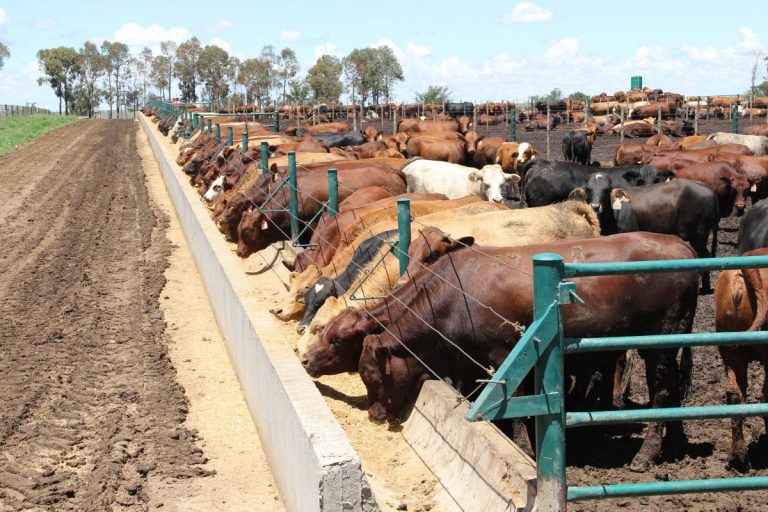Feed-lotting (also called pen fattening) involves the feeding of beef cattle with a high protein, energy balanced diet for a period of 60 to 90 days in confinement to increase live and slaughter weights. The basic principle of the feedlot is to increase the weight of each animal as quickly as possible. Depending on the initial body weight and target weight, animals that start out thin will generally take longer to reach slaughter weight.
Actual feeding practices
To help farmers successfully fatten up their cattle, we recommend the Novatek Feedlot 85 concentrate, which is a high protein fattening concentrate. To feed the animals, the farmer needs to mix the concentrate with raw materials such as maize bran or No 3 meal, maize silage, corn & cob, cotton cake, or sunflower cake in order to make feed. (See table below.)

Mixing instructions
There are generally two feeding systems used when fattening cattle:
Total mixed rations
Under total mixed rations, the roughage portion (mostly grass) is chopped into small pieces, mixed with the concentrate and the other raw materials, and then fed as a whole. This reduces sorting and selection of the feed by animals and will allow the animal to get all the required nutrients in the correct quantities.
Cafeteria system
Under the cafeteria system, the grass is fed separately from the concentrate feed. Farmers practicing the cafeteria system have an option of letting the animals graze, or cutting the grass and taking it to the animals. The concentrate feed has to be introduced slowly to help the animals adapt to the new feed. However, the grass has to be fed on a free choice basis to help keep the stomach healthy. Lack of roughage causes a drop in the rumen pH, causing acidosis.
Getting the best out of Novatek Feedlot 85
Factors to consider when using Feedlot 85:
Age
Young animals will put on weight much quicker than older animals. Younger animals will generally give you better quality meat than older animals.
Breed
Fast-growing breeds will generally give you higher yields. Exotic beef breeds will put on weight quicker than local breeds.
Grazing distance
Animals that do not move long distances to graze will gain weight quicker than animals that move long distances.
Health status
A healthy animal will eat more feed and put on weight quicker than one that is unhealthy.
Fresh water
An adequate supply of clean and fresh water ensures animals are hydrated at all times.
Space
Ensure there is adequate feeding space to help avoid overfeeding, and also prevent stronger animals from chasing others away from the feed.

Packaging: 40 kg
Introduce the feed gradually and mix ingredients thoroughly as recommended:
100 kg of molasses can replace maize bran/no 3 meal on a 1:1 basis in all rations containing no molasses.
TMR system: Start adapting animals by supplying the starter ration ad lib (free access) for 10 days, then move over to grower or finisher ration depending on the size and age of the animals.
Cafeteria system: This basically means that the hay is fed on an ad lib (free access) basis away from the mixed concentrate. Feed growers for light calves, followed by finisher. The adaption period will be as shown below:
Note: Grower rations are suitable for smaller animals weighing less than 350 kg, and finisher rations are suitable for animals heavier than 350 kg.
At Novatek we ensure that our farmers get the best nutrition and value for money to ensure that our customers are feeding for prosperity.
For more information on how to feed your beef cattle for optimum profitability, visit Novatek’s website www.novatekfeeds.com, or contact Robert Kanyembo on (+26)-978-779-017 or by sending an e-mail to salesmanager@novatek.co.zm.









Morning whati is the price per lg50n
Good day sir.Whats the price for feedlot 85?And where can I buy it from here in kabwe?
Hi Doubt,
For more information contact David on (+26)-978-779-017 or send an e-mail to salesmanager@novatek.co.zm. You can also leave your contact details here for them to reach you directly.
-Kind regards, Editorial